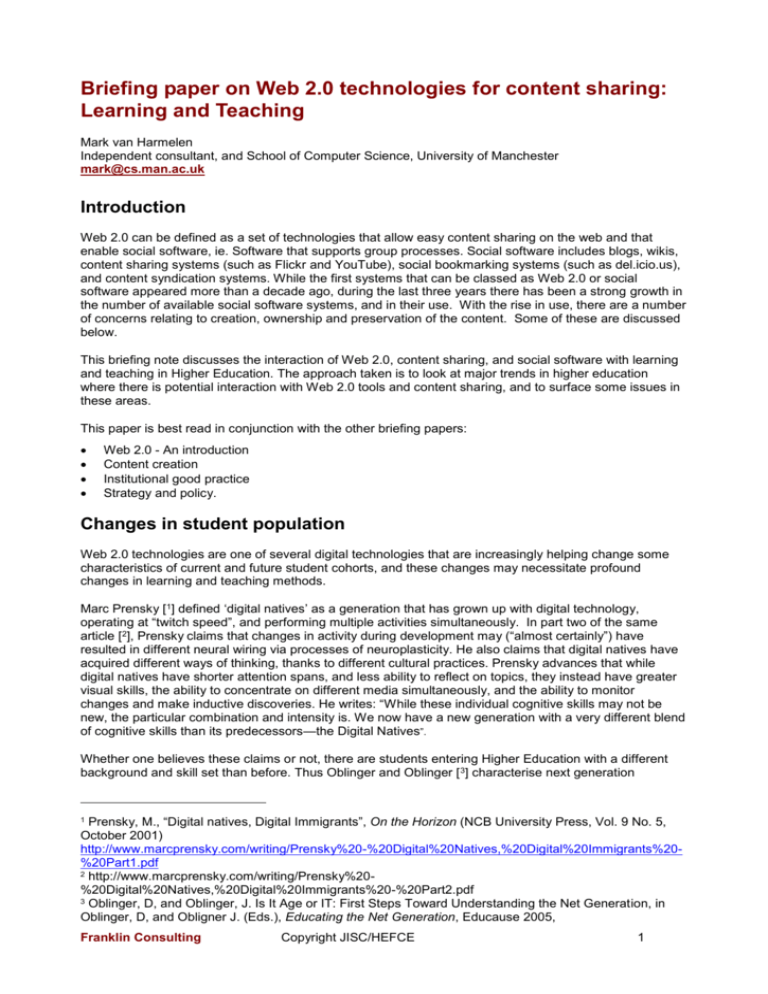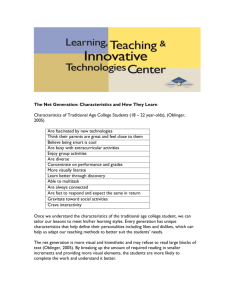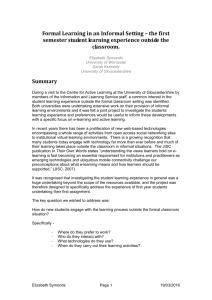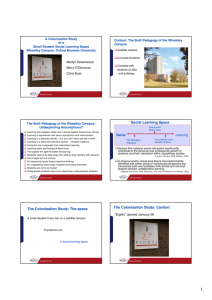Learning and teaching Briefing paper on Web 2
advertisement

Briefing paper on Web 2.0 technologies for content sharing: Learning and Teaching Mark van Harmelen Independent consultant, and School of Computer Science, University of Manchester mark@cs.man.ac.uk Introduction Web 2.0 can be defined as a set of technologies that allow easy content sharing on the web and that enable social software, ie. Software that supports group processes. Social software includes blogs, wikis, content sharing systems (such as Flickr and YouTube), social bookmarking systems (such as del.icio.us), and content syndication systems. While the first systems that can be classed as Web 2.0 or social software appeared more than a decade ago, during the last three years there has been a strong growth in the number of available social software systems, and in their use. With the rise in use, there are a number of concerns relating to creation, ownership and preservation of the content. Some of these are discussed below. This briefing note discusses the interaction of Web 2.0, content sharing, and social software with learning and teaching in Higher Education. The approach taken is to look at major trends in higher education where there is potential interaction with Web 2.0 tools and content sharing, and to surface some issues in these areas. This paper is best read in conjunction with the other briefing papers: Web 2.0 - An introduction Content creation Institutional good practice Strategy and policy. Changes in student population Web 2.0 technologies are one of several digital technologies that are increasingly helping change some characteristics of current and future student cohorts, and these changes may necessitate profound changes in learning and teaching methods. Marc Prensky [1] defined ‘digital natives’ as a generation that has grown up with digital technology, operating at “twitch speed”, and performing multiple activities simultaneously. In part two of the same article [2], Prensky claims that changes in activity during development may (“almost certainly”) have resulted in different neural wiring via processes of neuroplasticity. He also claims that digital natives have acquired different ways of thinking, thanks to different cultural practices. Prensky advances that while digital natives have shorter attention spans, and less ability to reflect on topics, they instead have greater visual skills, the ability to concentrate on different media simultaneously, and the ability to monitor changes and make inductive discoveries. He writes: “While these individual cognitive skills may not be new, the particular combination and intensity is. We now have a new generation with a very different blend of cognitive skills than its predecessors—the Digital Natives”. Whether one believes these claims or not, there are students entering Higher Education with a different background and skill set than before. Thus Oblinger and Oblinger [ 3] characterise next generation Prensky, M., “Digital natives, Digital Immigrants”, On the Horizon (NCB University Press, Vol. 9 No. 5, October 2001) http://www.marcprensky.com/writing/Prensky%20-%20Digital%20Natives,%20Digital%20Immigrants%20%20Part1.pdf 2 http://www.marcprensky.com/writing/Prensky%20%20Digital%20Natives,%20Digital%20Immigrants%20-%20Part2.pdf 3 Oblinger, D, and Oblinger, J. Is It Age or IT: First Steps Toward Understanding the Net Generation, in Oblinger, D, and Obligner J. (Eds.), Educating the Net Generation, Educause 2005, 1 Franklin Consulting Copyright JISC/HEFCE 1 (“n-gen”) students as digitally literate, highly Internet familiar, connected via networked media, used to immediate responses, preferring experiential learning, highly social (“being a friend of a friend is acceptable”), preferring to work in teams, craving interactivity in image rich environments (as opposed to text intensive environments), and having a preference “for structure rather than ambiguity”. Oblinger and Oblinger also point to a different kind of student, one who is non-traditional and working at the same time as studying. While their description is US-oriented, this kind of student is increasingly part of the UK HE landscape. Questions arise: Are these new student skill and preference sets different enough to demand changes in teaching methods to successfully engage with these students? Do the skill sets of incoming students demand (possibly only transitional) ‘remedial’ teaching, for example, in using libraries and finding primary sources? Is the changing student profile going to need different ways of teaching that, e.g., minimise traditional patterns of attendance and increase flexibility in where and when learning takes place? Somewhat anecdotally, there are different perspectives relating to student engagement (and therefore grades and retention): There is a recent case of a university teacher switching his instruction to a social medium (Facebook or MySpace) because the teacher’s students would not engage with the traditional VLE. Web 2.0 enabled approaches may therefore help engage with students. On the other hand, recent student interviews [4] in a humanities school in a UK University revealed that students were not concerned how they are taught (e.g. through lectures, seminars, or through a blended learning approach) so long as the instruction was good. This then raises the question of “what is good practice in learning and teaching in different modalities?” Group work, social constructivism, and constructionism As examples of areas/approaches where Web 2.0 tools can be deployed to good effect, we discuss their use in group work, including student generation of learning materials, and in social constructivist and constructionist approaches. Important questions lie on the intersection of current and future HE practice and the facilities offered by Web 2.0 enabled systems. The briefing note What is Web 2.0 identified that the content sharing inherent in Web 2.0 enabled the growth of social software; software that aids in group processes. Much of the following is discussed in terms of social software. Group work can often be aided by having social software available – this is no surprise when we note that social software is software that facilitates group process. Thus, for example: Blogs can be used in personal writing and groups critiques thereof. Wikis can be used by groups co-operatively producing artefacts directly in the wiki, or documenting group processes and external products [5]. Moving beyond support of group work, we note content sharing opportunities for students to create course and instructional materials. There is currently a divergence of opinion as to if students can create significantly good course materials using web 2.0 systems, and this is an interesting area where evidence will only emerge in a few years time. However, in some sense this is happening: If one acknowledges that Wikipedia is an educational aid there are exiting university courses where students, as part of their course work, contribute to Wikipedia articles. Allied to this trend, there are initiatives on the web to create university-level open course content using wikis. Social constructivism has as a central precept that knowledge is created by learners in the context of and as a result of social interaction. Social constructivist approaches are particularly aided by web 2.0 http://www.educause.edu/educatingthenetgen/ 4 So recent in fact that the academic commissioned to interview students has not even presented these results to the school concerned, precluding dissemination of the name of the particular school and university. 5 Incidentally, wikis can also be used as personal media, as, for example, as a dynamic personal logbook, serving the accretion of individual knowledge. Franklin Consulting Copyright JISC/HEFCE 2 tools as mediating mechanisms between collaborating students (and indeed, between students and teachers), particularly between students who might be sometimes be working in different places and at different times. Thus, for example, a group of students might construct an artefact in a wiki, but also be guided by a teacher who provides scaffolding in the same wiki. This scaffolding could take the form of wiki page structure and titles for pages to be filled in by the students, guidance as to areas to discuss in the wiki, the kind of content that is desired, and feedback on existing student produced content. In this way a teacher can help the students progress their learning in a Zone of Proximal Development, the “distance” between the actual level of the learners development and the level of their potential development [ 6]. Constructionism, advocated by Seymour Papert, is particularly amenable to Web 2.0 approaches. In Papert’s words ‘Constructionism … shares constructivism's connotation of learning as "building knowledge structures" irrespective of the circumstances of the learning. It then adds the idea that this happens especially felicitously in a context where the learner is consciously engaged in constructing a public entity, whether it's a sand castle on the beach or a theory of the universe.” ‘ Thus social software systems can be used for the construction of public entities, for example, via a video presentation on a social media system, a blog entry (for individual work) and a set of wiki pages (for individual and group work). Group work is essentially important if one takes the view that university is in part a preparation for the world of work, and that work is a group-based social activity. There are clearly major advantages to using Web 2.0 tools and social software in HE, particularly with regard to social constructivist approaches to education. An alternate view is that group work skills are at least as much a matter for learning how to facilitate group interaction and how to work co-operatively, and that social software tools merely ease group work processes. These two approaches are not mutually exclusive, social software systems enable sound pedagogic approach, but any change towards increased group work in HE needs to have its own elements of facilitation and co-operative group work training. Independent learners A major aim in UK HEIs is to produce independent (or autonomous) learners. A working definition is: Independent learners are self-directed learners who are able to set their own learning goals [ 7]; develop strategies and plan how to achieve those goals; work towards realising the goals, either on their own or with others; and reflect on their learning processes and outcomes, in turn learning by that process of reflection. The topic of independent learners abuts on that of control of learning, should it be teacher controlled, placed in the hands of the learners, or some amalgam of the two? The growing but still-nascent Personal Learning Environment (PLE) movement has a significant Web 2.0 following which claims that PLEs are social software tools that help or enable learners to take control of their own education. Unless we count web browsers as PLEs, there are few PLEs in existence today, and the question of whether we can build tools to enable, rather than help, the growth of independent learners as yet remain open. Possible issues and problems An incomplete set of problems and issues that arise in relation to / as a consequence of web 2.0 are: 1. The changing nature of students entering higher education may require a response, possibly in different directions. On one hand a move to supply engaging ways of tuition, on the other hand a need to supply ‘remedial’ teaching, in, e.g. reflection, use of primary sources. 2. While within HE there is often a need for a pragmatically chosen amalgam of pedagogic approaches that are selected on the basis of knowledge to be learned, learning and teaching context, desired learning outcomes, and so on, there may be a need for new pedagogic models to support (a) opportunities opened up by Web 2.0 technology, and (b) demands placed on the HE system by changed characteristics in student intake. 6 Vygotsky, L.S., Mind and society: The development of higher mental processes, translation, Cambridge, MA: Harvard University Press, 1978. 7 Clearly in an HE context, except in the most radical scenarios where the problem determines the syllabus, independent learning and its outcomes have to be aligned with syllabus requirements. Franklin Consulting Copyright JISC/HEFCE 3 3. Much Web 2.0 based student work is about content sharing and repurposing. This is can easily be seen by students as part of a new teen copy-and-paste culture that runs counter to traditional notions of plagiarism, and adjustments may need to be made; either to redefine plagiarism (unlikely to occur), or to help students transcend this culture in HE environments (more likely to occur). Increased group work moves from the model of individual work and individual assessment that underpins and forms the basis of higher education and requires a response that provides suitable assessment methods that allow HEIs to grade students for degree class. 4. Simply moving to increased group work in a relatively unplanned fashion because group work is assisted using Web 2.0 tools is not desirable. Good group work demands groups that function well at an intellectual level and have good group dynamics. As a Future lab report [ 8] states: “The quality of your learning community becomes significant if you are relying on a group to provide you with pointers and structures of information. If you are learning from a group – it had better be a good group.” One solution here is to retain teacher involvement in groups until they reach a state of quality in learning, peer co-teaching, and facilitated group dynamics. 5. In group work the nature of assessment needs to change in major ways to preserve the notion of individual assessment. In a recent survey [ 9] of student attitudes to group work the general attitude to assessment of group work was one of complaint that high achievers may be graded down, and low achievers or coasters may be graded up. Anecdotal evidence elsewhere points to extreme rigour in student assessments of each others contribution to group work, and, subject to further investigation, this student assessment of relative contribution could be folded into group work assessment approaches. 6. There may be changes in teacher roles. For example, in describing “Learning 2.0”, Stephen Downes writes: “Learning is characterised not only by greater autonomy for the learner, but also a greater emphasis on active learning, with creation, communication and participation playing key roles, and on changing roles for the teacher, indeed, even a collapse of the distinction between teacher and student altogether.” [10] It could be argued, however, that changes in teacher role will only happen in areas where the teacher and student knowledge are roughly equivalent. 7. There may be a skills and/or culture crisis as ‘old world’ teachers are forced to use unfamiliar tools and work and in unfamiliar ways and alien environments. 8. There may be economic factors at work, particularly in a world of widening participation in HE. Not all students may be digitally connected with a computer and Internet connection at home or in their digs, (or even in broadband connected university residences, if they are not a computer owner). These students would be at a profound disadvantage in a new world of Web 2.0 enabled learning without specific care being taken to address their computational and connectivity needs [ 11]. Conclusion Large changes in HE learning and teaching may be afoot, but it would be a mistake to consider these purely a consequence of Web 2.0. Rather they may more properly be described as an intersection of enabling technology with a growing zeitgeist that encompasses social learning theories. In this, the possible realms of learning to be opened up by the catalytic effects of Web 2.0 technologies are attractive, allowing greater student independence and autonomy, greater collaboration, and increased pedagogic efficiency. However, there are significant issues to consider in implementing these changes in HE. 8 Owen, M., Grant, L., Sayers, S, and Facer, K, Social Software and Learning, Futurelab, 2006. http://www.futurelab.org.uk/research/opening_education.htm 9 A sample of MSc students in the School of Computer Science, University of Manchester. 10 Downes, S., E-learning 2.0, eLearn Magazine, http://www.elearnmag.org/subpage.cfm?section=articles&article=29-1 11 Which raises the issue that students could be required to have an Internet enabled computer - just as they are required to have a pencil and paper, and be able to read. The onus for provision might not be on students though, e.g., Southampton’s Computer Science (ECS) gives any student who does not have a computer one of their old computers. Franklin Consulting Copyright JISC/HEFCE 4









